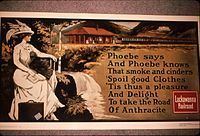 | ||
Phoebe Snow was a fictional character created by Earnest Elmo Calkins to promote the Delaware, Lackawanna and Western Railroad. The advertising campaign was one of the first to present a fictional character based on a live model amid impressionistic techniques.
Contents
The advertising campaign
Rail travel around 1900 was tough on the clothing of passengers. After a long trip on a coal-powered train, travellers frequently would disembark covered with black soot, unless the locomotives were powered by anthracite, a clean-burning form of coal. The Lackawanna owned vast anthracite mines in Pennsylvania, and could legitimately claim that the clothes of their passengers would remain clean after a long trip.
To promote this, the Calkins advertising department created, "Phoebe Snow", a young New York socialite, and a frequent passenger of the Lackawanna. The advertising campaign presented Miss Snow as often traveling to Buffalo, New York and always wearing a white dress. Calkins said he based the campaign on an earlier series of Lackawanna car cards (advertisements displayed inside coaches) - All in Lawn - created by DL&W advertising manager, Wendell P. Colton. They had been built on a rather limiting nursery rhyme, The House That Jack Built, and featured a nameless heroine dressed in white. For his new campaign, Calkins adopted a form of verse inspired by an onomatopoetic rhyme, Riding on the Rail, that he felt offered endless possibilities.
The first advertisement featured the image of Phoebe and a short poem:
Says Phoebe Snowabout to goupon a trip to Buffalo"My gown stays whitefrom morn till nightUpon the Road of Anthracite"Phoebe soon became one of the most recognized advertising mascots in the United States, and she began to enjoy all the benefits offered by DL&W: gourmet food, courteous attendants, an observation deck, even onboard electric lights:
Now Phoebe mayby night or dayenjoy her book upon the wayElectric lightdispels the nightUpon the Road of Anthracite"Phoebe Snow" was the only name Calkins ever used in the advertisements, and he laughed at later claims by Lackawanna officials that the name was selected only after lengthy scientific experimentation. The original artwork was painted by Henry Stacy Benton, who worked from a series of images of a model, Marion Murray Gorsch. Later, she was photographed in a variety of railroad activities while dressed in a white gown. Standing in for the cool, violet-corsaged Phoebe character of the paintings, Gorsch was one of the first models to be used in advertising.
During World War I, anthracite was needed for the war effort and its use on railroads was prohibited, thus ending the career of Phoebe Snow. As she passed into legend, the Calkins heroine said farewell with the following jingle:
Miss Phoebe's tripwithout a slipis almost o'erHer trunk and gripare right and tightwithout a slight"Good bye, old Road of Anthracite!"Revival of the name
On November 15, 1949, the Lackawanna Railroad inaugurated a new streamlined passenger train named after its long-dormant promotional symbol. The new Phoebe Snow represented the modernization of the Lackawanna passenger train fleet, and its image. The new train became Train No. 3 (westbound) and No. 6 (eastbound), which previously had been assigned to the railroad's formerly premier train, the Lackawanna Limited.
The Phoebe Snow ran on a daylight schedule between Hoboken, N.J., and Buffalo, N.Y., a trip of 396 miles (639 km), in about eight hours. The train was discontinued in 1966.
Singer Phoebe Snow took her stage name from the character.
